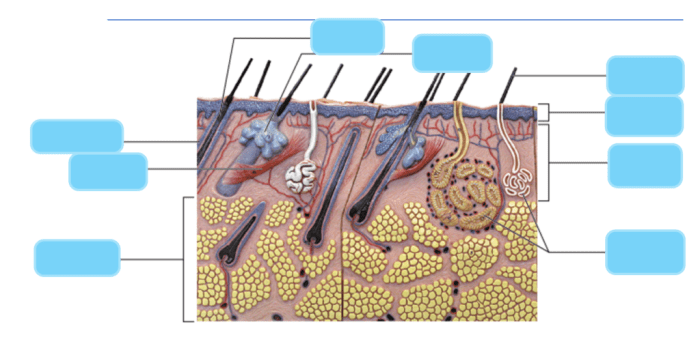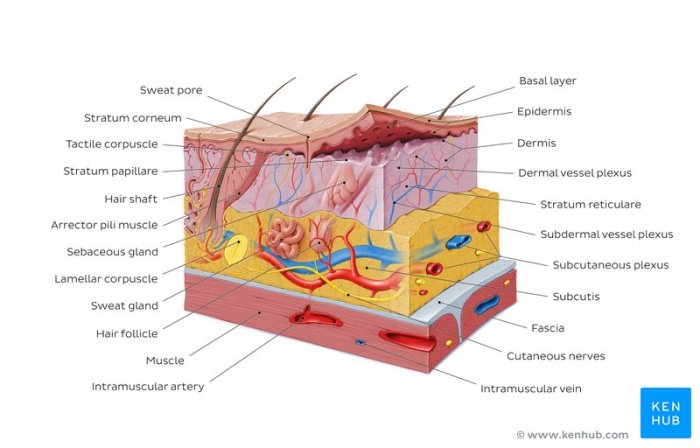Laboratory exercise 7 integumentary system answers delve into the fascinating realm of the skin, its structures, functions, and disorders. This comprehensive guide unravels the intricacies of the integumentary system, providing a thorough understanding of its significance in maintaining overall health and well-being.
Through a meticulous examination of laboratory exercises, this discourse unveils key findings and observations that illuminate the vital role of the skin as a protective barrier, a sensory organ, and a regulator of body temperature. The exploration extends to common skin disorders, their symptoms, causes, and potential treatment options, empowering readers with essential knowledge for maintaining healthy skin.
Integumentary System Overview: Laboratory Exercise 7 Integumentary System Answers

The integumentary system is the outermost layer of the body and serves as a protective barrier against the external environment. It consists of the skin, hair, nails, and glands, which work together to regulate body temperature, prevent dehydration, and protect against pathogens.
The skin, the largest organ of the integumentary system, is composed of three layers: the epidermis, dermis, and hypodermis. The epidermis, the outermost layer, is made up of keratinized cells that protect the body from external threats. The dermis, the middle layer, contains blood vessels, nerves, and connective tissue that provide nourishment and support.
The hypodermis, the innermost layer, is composed of fat cells that insulate the body and provide cushioning.
Skin Structures, Laboratory exercise 7 integumentary system answers
In addition to the three layers of skin, the integumentary system also includes various skin structures, including hair, nails, and glands.
- Hairis made of keratin and helps protect the body from heat loss, UV radiation, and physical trauma.
- Nailsare hard, keratinized structures that protect the tips of the fingers and toes.
- Glandssecrete substances onto the skin surface and include sweat glands, sebaceous glands, and mammary glands.
Skin Disorders
The integumentary system is prone to various disorders, including:
- Acneis a common skin disorder characterized by the formation of pimples and blackheads due to clogged hair follicles.
- Eczemais a chronic skin condition that causes inflammation, redness, and itching.
- Psoriasisis an autoimmune disorder that leads to the formation of thick, scaly patches on the skin.
Laboratory Exercise Analysis
Laboratory exercises on the integumentary system can provide valuable insights into its structure and function.
| Exercise | Findings | Significance |
|---|---|---|
| Microscopic Examination of Skin | Reveals the different layers of skin and their cellular components. | Helps understand the structure and function of the skin as a protective barrier. |
| Skin pH Measurement | Determines the acidity or alkalinity of the skin’s surface. | Provides information about the skin’s ability to protect against pathogens and maintain moisture. |
| Transepidermal Water Loss Measurement | Measures the amount of water lost through the skin. | Assesses the skin’s ability to prevent dehydration and maintain its integrity. |
Further Exploration
For further exploration of the integumentary system, consider the following:
- Resources:
- National Institute of Arthritis and Musculoskeletal and Skin Diseases: https://www.niams.nih.gov/health-topics/skin-conditions
- American Academy of Dermatology: https://www.aad.org/
- Current Research: Explore recent advancements in dermatology, such as stem cell therapy for skin regeneration and laser treatments for skin disorders.
- Careers: Consider careers related to the integumentary system, including dermatologist, cosmetologist, and skincare specialist.
Commonly Asked Questions
What is the primary function of the integumentary system?
The integumentary system primarily serves as a protective barrier against external threats, preventing the entry of pathogens, harmful substances, and excessive water loss.
Name the three layers of the skin.
The skin comprises three distinct layers: the epidermis, dermis, and hypodermis, each with specialized functions and structural characteristics.
What are the common symptoms of acne?
Acne is characterized by the presence of pimples, blackheads, and whiteheads, often accompanied by inflammation, redness, and scarring.

